How to Draw
Landscape Drawing
IntroductionYou have worked with many different drawing techniques in this unit. We want to examine more closely how we look at the word around us and use our perception and drawing techniques to create a landscape drawing.
Viewfinder
Often when a painter is faced with a scene, there's simply so much that's
 appealing it's hard to choose what to focus on. This is where a viewfinder comes in useful, as it helps you focus on particular parts of the scene, enabling you to decide what will make the best composition, both in terms of focus and format. To help you see portions of your environment or possible focal points, you can make a viewfinder (a piece of card
appealing it's hard to choose what to focus on. This is where a viewfinder comes in useful, as it helps you focus on particular parts of the scene, enabling you to decide what will make the best composition, both in terms of focus and format. To help you see portions of your environment or possible focal points, you can make a viewfinder (a piece of card  with a window cut into it of the same proportions as your drawing paper). Hold the viewfinder in front of your eye, and frame the thing you are drawing. Use the frame of the viewfinder to create a boundary for the area you want to draw.
with a window cut into it of the same proportions as your drawing paper). Hold the viewfinder in front of your eye, and frame the thing you are drawing. Use the frame of the viewfinder to create a boundary for the area you want to draw. If you look at this landscape, you'll quickly see the potential for various landscape paintings. By using a viewfinder to isolate just a part of the landscape and to frame it in a particular way, it's easier to judge whether a composition is pleasing or not. For instance, you could crop out all the foreground, including the whole town, for a composition that focuses on the mountains. As a composition it's strong, yet for a landscape painting doesn't give you much of a feeling for the area.
If the town is included, as here, the whole feeling of the composition changes.
 Suddenly the mountains aren't the primary focus, but a background. The town and the farmlands dominate, yet there isn't a strong focal point to draw the viewer into the painter. As a composition it's rather mundane.
Suddenly the mountains aren't the primary focus, but a background. The town and the farmlands dominate, yet there isn't a strong focal point to draw the viewer into the painter. As a composition it's rather mundane.If you move the viewfinder to the right, so that the mountain runs off the left edge of the painting and the open farmland runs from the foreground off into the distance to the right, you get a much more rural scene. Yes, the town is there, but the focus is on the farmlands and the feeling of distance they create as they vanish into the horizon. As a composition, it is quite pleasing, but you'd need to decide whether you were happy with the very square format.
Depth Perception
 Depth is how deep or three-dimensional an artwork looks. Artists create depth and space with a variety of techniques and tricks that fool the eye. The illusion of space can be created using color, line, and shape. Western artists in the 16th century developed a mathematical system to create the illusion depth called perspective.
Depth is how deep or three-dimensional an artwork looks. Artists create depth and space with a variety of techniques and tricks that fool the eye. The illusion of space can be created using color, line, and shape. Western artists in the 16th century developed a mathematical system to create the illusion depth called perspective.